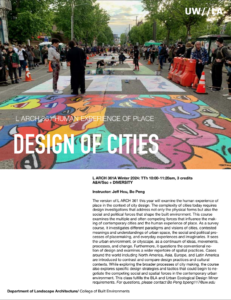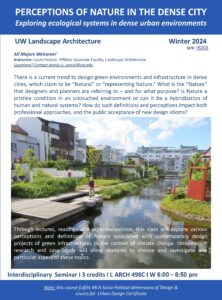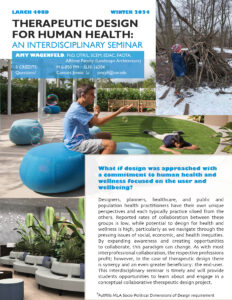Submitted by Stephen Dunne
on
We still have availability in a few Landscape Architecture courses in Winter quarter that are open to all majors. All of these course credits may be applied towards the Urban Ecological Design Minor, as well as may apply towards other Gen Ed requirements - details available in the links provided and below.

L Arch 361: Human Experience of Place
Jeff Hou, Bo Peng 3 credits, A&H/SSc+Diversity TTh 10:00-11:20 SLN: 16194 The version of L ARCH 361 this year will examine the human experience of place in the context of city design. The complexity of cities today requires design investigations that address not only the physical forms but also the social and political forces that shape the built environment. This course examines the multiple and often competing forces that influence the making of contemporary cities and the human experience of place. As a survey course, it investigates different paradigms and visions of cities, contested meanings and understandings of urban space, the social and political processes of placemaking, and everyday experiences and imaginaries. It sees the urban environment, or cityscape, as a continuum of ideas, movements, processes, and change. Furthermore, it questions the conventional notion of design and examines a wider repertoire of spatial practices. Cases around the world including North America, Asia, Europe, and Latin America are introduced to contrast and compare design practices and cultural contexts. While exploring the broader processes of city-making, the course also explores specific design strategies and tactics that could begin to negotiate the competing social and spatial forces in the contemporary urban environment. This class fulfills the BLA and Urban Ecological Design Minor requirements.

L Arch 498C: Perceptions of Nature in the Dense City
Laure Heland 3 credits W 6:00-8:50 SLN: 16203
There is a current trend to design green environments and infrastructure in dense cities, which claim to be “Natural” or “representing Nature.” What is the “Nature” that designers and planners are referring to – and for what purpose? Is Nature a pristine condition in an untouched environment or can it be hybridization of human and natural systems? How do such definitions and perceptions impact both professional approaches, and the public acceptance of new design idioms?

L Arch 498D: Therapeutic Design for Human Health
Amy Wagenfeld (licensed occupational therapist) 3 credits M 6:00-8:50 SLN: 16204 What if design was approached with a commitment to human health and wellness focused on the user and wellbeing?
Designers planners, healthcare, and public and population health practitioners have their own unique perspectives and each typically practice siloed from the others. Reported rates of collaboration between these groups is low, while potential to design for health and wellness is high, particularly as we navigate through the pressing issues of social, economic, and health inequalities. By expanding awareness and creating opportunities to collaborate, this paradigm can change. As with most interprofessional collaboration, the respective professions profit; however, in the case of therapeutic design there is synergy and an even greater beneficiary: the end-use. This interdisciplinary seminar is timely and will provide students opportunities to learn about and engage in a conceptual collaborative therapeutic design project